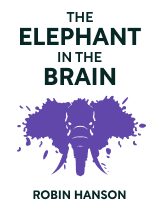

This article is an excerpt from the Shortform book guide to "The Elephant in the Brain" by Robin Hanson and Kevin Simler. Shortform has the world's best summaries and analyses of books you should be reading.
Like this article? Sign up for a free trial here .
How can you determine the true motives behind behaviors? How can you become less selfish and purer in your own motives?
In The Elephant in the Brain, Kevin Simler and Robin Hanson argue that human behavior is driven by selfish motives hidden behind altruistic pretexts. They call these selfish motives the “elephant in the brain.” If we learn to recognize these “elephants,” we can improve our individual behaviors and our social institutions.
Continue reading for some tips on recognizing hidden motives in yourself and others.
Recognizing Hidden Motives
If hidden motives really are as prevalent as Simler and Hanson say, we might be left with a bleak picture of humanity. The authors themselves acknowledge that we might not be happy to hear their insights—few of us want to admit when we’re driven by selfishness and other “bad” motives. Perhaps worse is the thought that our valued social institutions are based on selfish deception.
But, there’s a silver lining to learning about the elephant: Once we recognize it, we can do something about it. Here are a few ideas about how taming the elephant lets us …
- … become less selfish and less self-deceived. For example, a researcher who honestly acknowledges that her work is driven in part by a desire to advance her career and win acclaim will be more likely to resist the temptation to doctor her results in order to get published. That’s because she’ll be able to choose between her (no longer) hidden desire for self-advancement and her altruistic desire to further scientific knowledge.
- (Shortform note: According to stoicism popularizer Ryan Holiday, unchecked selfish motives can actually get in the way of your career. In Ego Is the Enemy, Holiday argues that aiming for recognition causes you to compromise your values—instead, he suggests focusing on accomplishing things that will make a difference to your profession or to the world at large.)
- … accept our selfishness and transform it into enlightened self-interest by deliberately helping others in order to advance ourselves. For example, businesses with strong charitable cultures might enjoy better sales and customer loyalty—but only if their charitable engagement is genuine and effective. When businesses are honest about their desire to make money, it’s easier to see how helping others can actually advance this selfish goal.
- (Shortform note: We tend to think of selfishness and selflessness as opposites, but according to Adam Grant, they are independent motivations, meaning that you can be selfish and selfless at the same time. In fact, in Give and Take, Grant argues that balancing these two motivations is crucial to your happiness and mental health.)
- … design better institutions. The authors point out that we can’t change our social systems until we understand the hidden motives that drive them. For example, if we want to reform the penal system, we first need to recognize how unspoken motives (like the desire to have criminals suffer) are at odds with our stated goals (to rehabilitate offenders or to remove them from society for everyone’s safety).
- (Shortform note: For example, being aware of our true motives might help reduce what Daniel Kahneman, Olivier Sibony, and Cass R. Sunstein call noise—unwanted variances in judgment that reduce the quality and consistency of our social systems. In Noise, the authors argue that the variances result in part from differences in opinion and perspective from one judger to the next. For example, if a group of judges says they believe in rehabilitation—but some of them have hidden vengeance or punishment motivations—then as a whole, their sentencing decisions will be noisy.)
Exercise: Spot Your Own Elephants
Simler and Hanson argue that many of our actions are driven by selfish motives hidden behind altruistic facades. They say these motives—and our tendency to hide them—are built into the human brain, which means none of us are immune. With that in mind, see if you can identify some of your own elephants.
- Describe a time when you did or said something that you presented as selfless but was in fact selfish. Keep in mind that at the time, you may have genuinely thought your action was selfless.
- What was the real motivation behind your action? Why wouldn’t you have wanted to admit this motivation to others or yourself?
- If you face the same situation again, now armed with this awareness, do you think you will act differently? How so?

———End of Preview———
Like what you just read? Read the rest of the world's best book summary and analysis of Robin Hanson and Kevin Simler's "The Elephant in the Brain" at Shortform .
Here's what you'll find in our full The Elephant in the Brain summary :
- How human behavior is driven by selfish motives
- Why your own brain is hiding your intentions from you
- Why the purpose of education is to certify future employees






